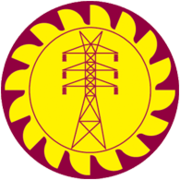 | |
Native name | ලංකා විදුලිබල මණ්ඩලය - ලංවිම (இலங்கை மின்சார சபை - இமிச) |
|---|---|
| Company type | Government-owned corporation |
| Industry | Electricity generation, Electricity transmission, Electricity distribution, Electricity retailing |
| Founded | 1969 |
| Fate | Privatised |
| Headquarters | 50 Sir Chittampalam A, Gardiner Mawatha, Colombo, Sri Lanka |
Key people | M.M.C. Ferdinando (Chairman) Eng. (Dr.) Narendra De Silva (Acting General Manager) [1][2] |
Production output | |
| Revenue | |
| Total assets | |
| Total equity | |
Number of employees | |
| Parent | Ministry of Power |
| Subsidiaries | Lanka Electricity Company (55.2%) Lanka Coal Company LTL Holdings |
| Website | www |
The Ceylon Electricity Board - CEB (Sinhala: ලංකා විදුලිබල මණ්ඩලය - ලංවිම, romanized: Lankā Vidulibala Mandalaya - Lanwima; Tamil: இலங்கை மின்சார சபை - இமிச), was the largest electricity company in Sri Lanka. With a market share of nearly 100%, it controlled all major functions of electricity generation, transmission, distribution and retailing in Sri Lanka. It was one of the only two on-grid electricity companies in the country; the other being Lanka Electricity Company (LECO). The company earned approximately Rs 204.7 billion in 2014, with a total of nearly 5.42 million consumer accounts. It was a government-owned and controlled utility of Sri Lanka that took care of the general energy facilities of the island. The Ministry of Power and Energy was the responsible ministry above the CEB. Ceylon Electricity Board (CEB), established by the CEB Act No. 17 of 1969, was under the legal obligation to develop and maintain an efficient, coordinated and economical system of electricity supply in accordance with any licenses issued. The CEB was dissolved and replaced by 12 successor entities under the 2024 Electricity Act.[5][6][7]
- ^ "Corporate Profile". Archived from the original on 11 May 2020. Retrieved 9 June 2024.
- ^ "Our Management". CEB. Archived from the original on 22 July 2015. Retrieved 20 July 2015.
- ^ a b "Sri Lanka's CEB loses Rs4.5bn up to June". EconomyNext. 17 August 2021. Archived from the original on 24 February 2022. Retrieved 24 February 2022.
- ^ a b c d "Ceylon Electricity Board 2019" (PDF). Ceylon Electricity Board. Ceylon Electricity Board. Archived (PDF) from the original on 18 September 2021.
- ^ "2024 Electricity Act Reforms". The Morning. Retrieved 9 June 2024.
- ^ "Sri Lanka passes new electricity law". EconomyNext. Retrieved 9 June 2024.
- ^ "Sri Lanka Electricity Bill Gazette" (PDF). Documents.gov.lk. Retrieved 9 June 2024.